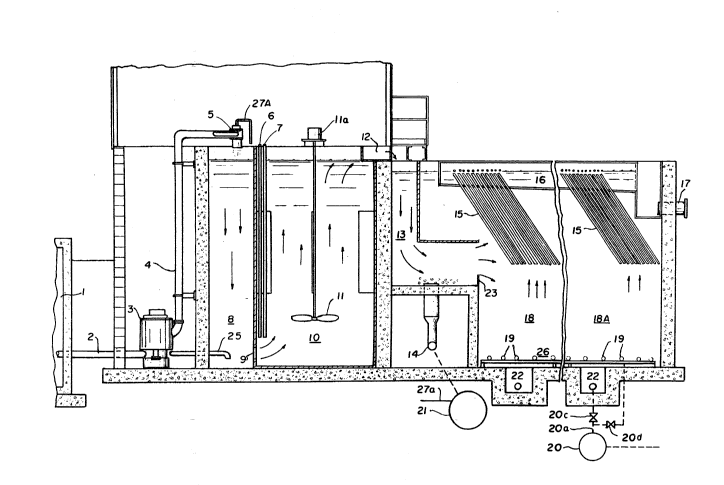Some of the information on this Web page has been provided by external sources. The Government of Canada is not responsible for the accuracy, reliability or currency of the information supplied by external sources. Users wishing to rely upon this information should consult directly with the source of the information. Content provided by external sources is not subject to official languages, privacy and accessibility requirements.
Any discrepancies in the text and image of the Claims and Abstract are due to differing posting times. Text of the Claims and Abstract are posted:
| (12) Patent: | (11) CA 1332006 |
|---|---|
| (21) Application Number: | 587726 |
| (54) English Title: | LIQUID WASTE TREATMENT SYSTEM |
| (54) French Title: | SYSTEME DE TRAITEMENT DES DECHETS LIQUIDES |
| Status: | Deemed expired |
| (52) Canadian Patent Classification (CPC): |
|
|---|---|
| (51) International Patent Classification (IPC): |
|
| (72) Inventors : |
|
| (73) Owners : |
|
| (71) Applicants : | |
| (74) Agent: | FETHERSTONHAUGH & CO. |
| (74) Associate agent: | |
| (45) Issued: | 1994-09-13 |
| (22) Filed Date: | 1989-01-09 |
| Availability of licence: | N/A |
| (25) Language of filing: | English |
| Patent Cooperation Treaty (PCT): | No |
|---|
| (30) Application Priority Data: | None |
|---|
ABSTRACT OF THE DISCLOSURE
A method of treating and progressively densifying liquid waste.
It comprises thoroughly mixing and aerating by a continuous mixer and/or
aerating raw water and chemical treating materials, discharging the
resulting mixture downwardly into a reaction compartment, thence
drawing the resulting material upwardly by means of an impeller and
gravity flow, then allowing a portion of the resulting denser sludge
to descend downwardly by gravity into a floc tunnel, thence in a
horizontal portion, further densifying and separating takes place. The
remaining portion is directed horizontally against inclined, closely
spaced parallel plates to clear the resulting fines mixture. Thereafter,
there is still further densifying the sludge. By this method, a
very dense sludge is obtained in a relatively small space.
Note: Claims are shown in the official language in which they were submitted.
Note: Descriptions are shown in the official language in which they were submitted.

For a clearer understanding of the status of the application/patent presented on this page, the site Disclaimer , as well as the definitions for Patent , Administrative Status , Maintenance Fee and Payment History should be consulted.
| Title | Date |
|---|---|
| Forecasted Issue Date | 1994-09-13 |
| (22) Filed | 1989-01-09 |
| (45) Issued | 1994-09-13 |
| Deemed Expired | 2003-09-15 |
There is no abandonment history.
| Fee Type | Anniversary Year | Due Date | Amount Paid | Paid Date |
|---|---|---|---|---|
| Application Fee | $0.00 | 1989-01-09 | ||
| Registration of a document - section 124 | $0.00 | 1989-03-20 | ||
| Registration of a document - section 124 | $0.00 | 1991-05-07 | ||
| Registration of a document - section 124 | $0.00 | 1994-07-15 | ||
| Maintenance Fee - Patent - Old Act | 2 | 1996-09-13 | $50.00 | 1996-06-06 |
| Maintenance Fee - Patent - Old Act | 3 | 1997-09-15 | $100.00 | 1997-07-10 |
| Maintenance Fee - Patent - Old Act | 4 | 1998-09-14 | $100.00 | 1998-09-14 |
| Maintenance Fee - Patent - Old Act | 5 | 1999-09-13 | $150.00 | 1999-09-09 |
| Maintenance Fee - Patent - Old Act | 6 | 2000-09-13 | $150.00 | 2000-08-22 |
| Maintenance Fee - Patent - Old Act | 7 | 2001-09-13 | $150.00 | 2001-09-12 |
Note: Records showing the ownership history in alphabetical order.
| Current Owners on Record |
|---|
| HAZLETON ENVIRONMENTAL PRODUCTS INC. |
| W. & P. INVESTMENTS, INC. |
| Past Owners on Record |
|---|
| DECKER, CLIFFORD J. |
| GALGON, RANDY A. |
| HAZLETON ENVIRONMENTAL PRODUCTS INC. |
| WERNER, ROY H. |